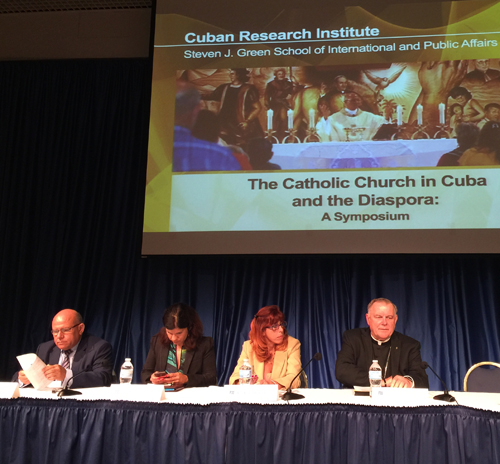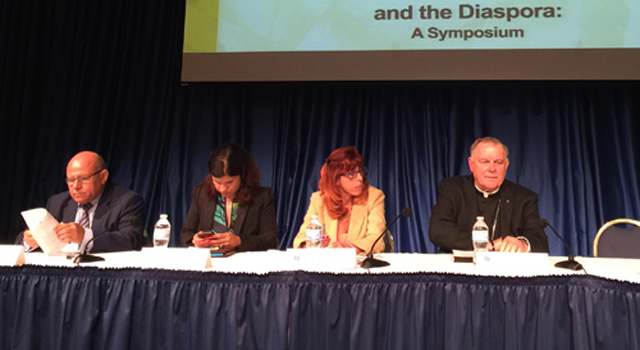By Archbishop Thomas Wenski - The Archdiocese of Miami
At a panel discussion at FIU, Archbishop Wenski discussed the meaning of Pope Francis’ trip to Cuba.
Pope Francis arrives in Cuba at a time of renewed hopes because of the reestablishment of diplomatic relations between Cuba and United States. That the Pope played a key role in helping make this happen will not be lost of anyone in Cuba.
In 1998, SAINT JOHN PAUL II said that Cuba should open itself to the world and that the world should open itself to Cuba. And now, Pope Francis is flying to the US � not directly from Rome but from Cuba. The Pope likes to make symbolic gestures � he carries his own bag, for example. His flight into Washington, DC from Havana is also very symbolic. As he told priests at an ordination a couple of years ago, priests are to build bridges not walls. He is building a bridge. And this bridge not only spans the distance between Cuba and the US, but � I think � it is meant also to span the distance between the US and Latin America, the distance between the most developed part with those parts, in many cases, that are the least developed.
Pope Francis will be the third Pope that has visited Cuba. In this hemisphere, only Brazil so far can make such a claim. Of course, the USA will be added to this group when Pope Francis arrives here after his Cuban visit.
The interpretative key to each visit of these three Popes is to be found in the “lema” or slogan that helped publicized these visits.

Archbishop Thomas Wenski at panel discussion regarding Pope Francis' upcoming visit to Cuba.
And, perhaps thanks to his visit, a greater understanding of the Church from outside the island, especially from Cuba’s diaspora was arrived at. Just some examples, shortly after SAINT JOHN PAUL II visit, the Cuban Association of Knights of Malta began supporting a growing number of “comedores” throughout the island. Also, annual meetings between Cuban church leaders (priests and laity) began with Church leaders in the exile community � and they still continue today fostering mutual understanding between Cuban Catholics who find themselves on opposite sides of the Florida straits.
Second, POPE BENEDICT XVI came to Cuba in 2012. He came as a pilgrim of charity � he did so to commemorate the 400 anniversary of the discovery and presence of the image of Our Lady of Charity in Cuba. His visit was preceded by a year long pilgrimage of the Virgen Mambisa throughout the island � and it is estimated that more than four million people saw the image during this pilgrimage. On the plane to Cuba, POPE BENEDICT XVI told reporters that “Marxism is a bankrupt ideology” � to which when asked by reporters on the island, Archbishop Dionisio Garcia of Santiago replied: “the Pope didn’t say anything that we in Cuba don’t already know”. But, when he arrived in Cuba Benedict spoke about “la casa Cuba” � how Cuba should be a home for all Cubans � of whatever ideological position and wherever they might live.
Now, Pope Francis goes as a “missionary of Mercy”. If you did a word search of Pope Francis’ homilies and speeches the word “mercy” would likely be the most used. On Cuba soil, where 50 years of Marxist ideology has wrought some significant anthropological damage in every Cuban’s psyche, Pope Francis will say � give your brother, give your sister your heart � not stones or insults. Mercy means to forgive and to seek forgiveness: and in a place where someone has been betrayed or felt betrayed by someone else mutual forgiveness � mercy � will be needed if the society is to experience a peaceful transition. After all, you cannot build a future of hope on a foundation of resentments.
I’ve often said that the Church in Cuba has admirably and coherently accompanied the Cuba people sharing with the people from its own poverty. This walking with the people was a deliberate decision of the Catholics of Cuba � one arrived at in the mid 1980’s through the ENEC process. (Encuentro Nacional Eclesial de Cuba). In this accompaniment, the Church has patiently sought to gain “space” � the space to be Church, the space to carry out her mission of evangelization. Caritas Cuba, the works of the Knights of Malta are examples of space gained. Through these activities � and even through the work of organizing and making operational a papal visit that requires close collaboration (or better word, cooperation) of lay Catholics throughout the island with the authorities the Church is helping to rebuild civil society.
The Church in Cuba wants a “soft landing” for any future transition � that the Pope is going to Cuba represents that he agrees with the Cuban Church in this goal � and he also sees with them the rapprochement between US and Cuba (and hopefully the end of the embargo) as the right steps to such a soft landing.
Pope Francis has a special devotion to Nuestra Senora Desatanudos, Our Lady Un-tier of Knots.
Here in Miami, I will ask Cubans to pray a special Novena from Sept 9 to Sept 18 � from the day after feast day of Our Lady of Charity till the day before the Pope lands in Cuba.
Each day we will pray asking the intercession of Our Lady of Charity to untie a knot: the knot of discourage, the knot of indifference, the knot of individualism, the knot of exclusion and social marginalization, the knot of the loss of values, the knot of egoism, the knot of the lack of hope, the knot of the lack of authenticity and the knot of the lack of mercy. After 50 years the situation is Cuba is “enredado”. Francis’s visit � as a missionary of mercy � is about untying some of those knots.

